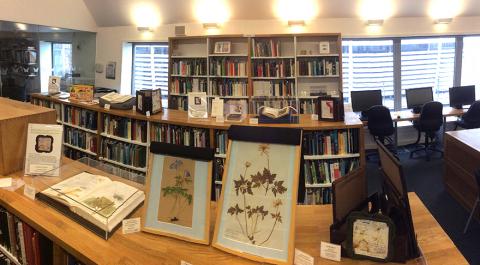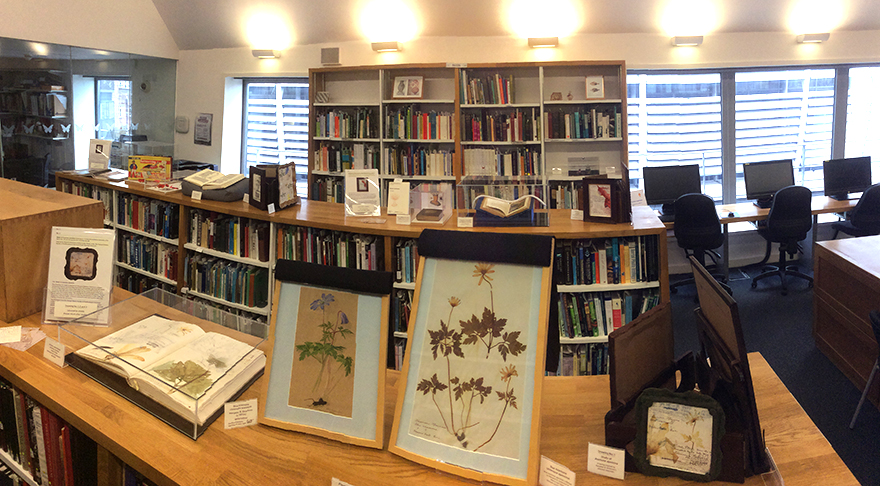Anemones of the Spirit Sea Air and Juvenescence
This set of 9 drawings of Anemones (flowers, animals and toys) was inspired by research in the archives of the Natural History Society of Northumbria (in whose library my exhibition 'Anemones of the Spirit, Sea, Air and Juvenescence was held in 2018) and the collections of the Great North Museum: Hancock. As we study these archival treasures of art and science we might take a moment to consider our own place in the world. The ever-changing labels and identifications that accompany such objects embody not only our search for understanding, but also our willingness to embrace what marvels the world reveals to us. Each drawing was made to fit a vintage frame.
-
Anemones Exhibition View 1. Natural History Society of Northumbria LibraryAnemones Exhibition View 1. Natural History Society of Northumbria LibraryView of Anemones Exhibition in the Natural History Society of Northumbria library, 2018.
2017 -
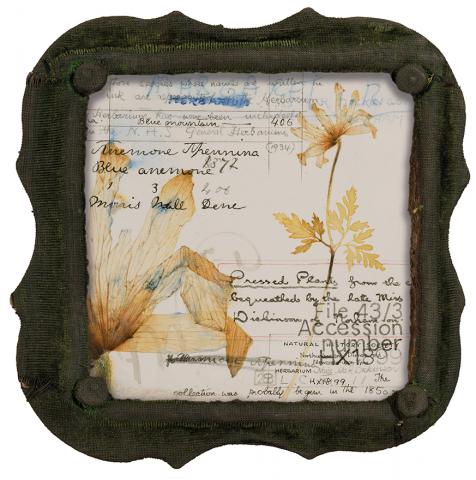 Study of Anemone Apennina
Study of Anemone Apennina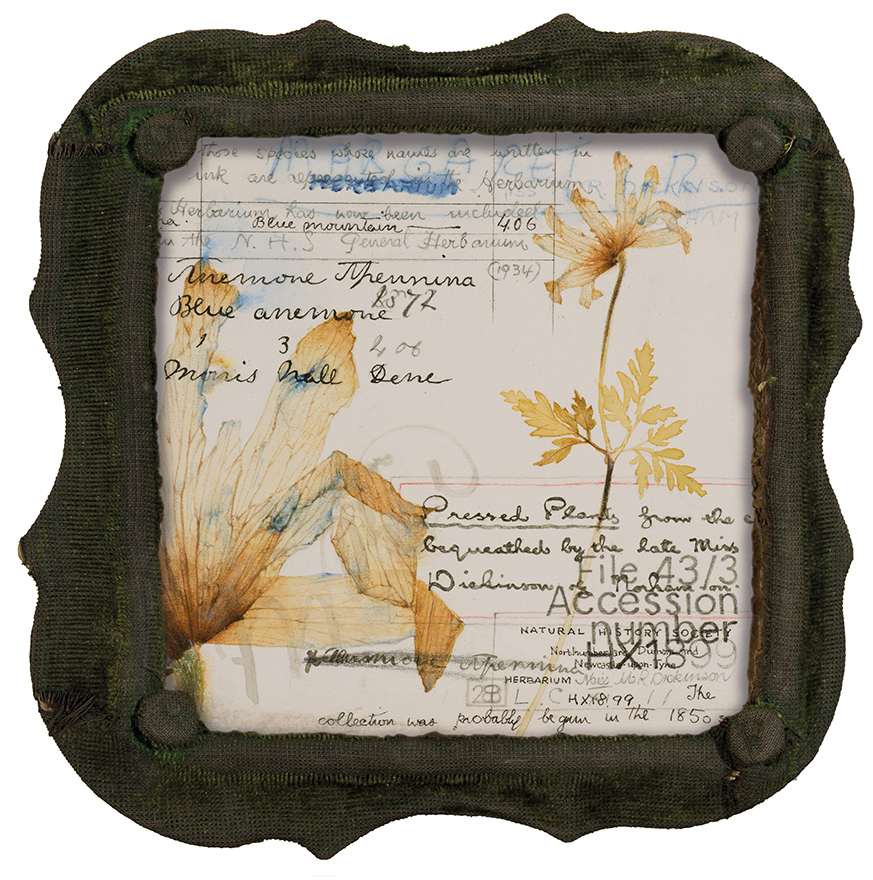 Study of Anemone ApenninaInspired by the pressed specimen of Anemone apennina in the Margaret Rebecca Dickinson (a Victorian botanist) archive in the Natural History Society of Northumbria, I was struck by the touches of lovely blue colour that it retains. It is as if the dead flower is preserved with some of it's living energy and it has something of a 'Vanitas' quality about it. The text ranges from Dickinson's beautiful handwritten material through to subsequent records from researchers to date. This drawing is almost a palimpsest: an embodiment of layered time from the living flower, through it's death, through Dickinson herself and later botanists and artists until I made my own discovery of her delicate little anemone specimen.
Study of Anemone ApenninaInspired by the pressed specimen of Anemone apennina in the Margaret Rebecca Dickinson (a Victorian botanist) archive in the Natural History Society of Northumbria, I was struck by the touches of lovely blue colour that it retains. It is as if the dead flower is preserved with some of it's living energy and it has something of a 'Vanitas' quality about it. The text ranges from Dickinson's beautiful handwritten material through to subsequent records from researchers to date. This drawing is almost a palimpsest: an embodiment of layered time from the living flower, through it's death, through Dickinson herself and later botanists and artists until I made my own discovery of her delicate little anemone specimen.
h:19.5cms x w:19.5cms (framed).
watercolour and pencil on paper
2018 -
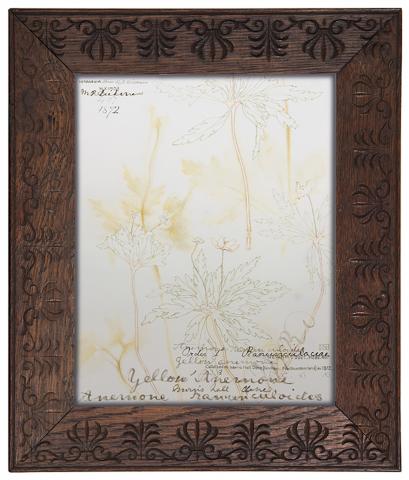 Study of Anemone Ranunculoides
Study of Anemone Ranunculoides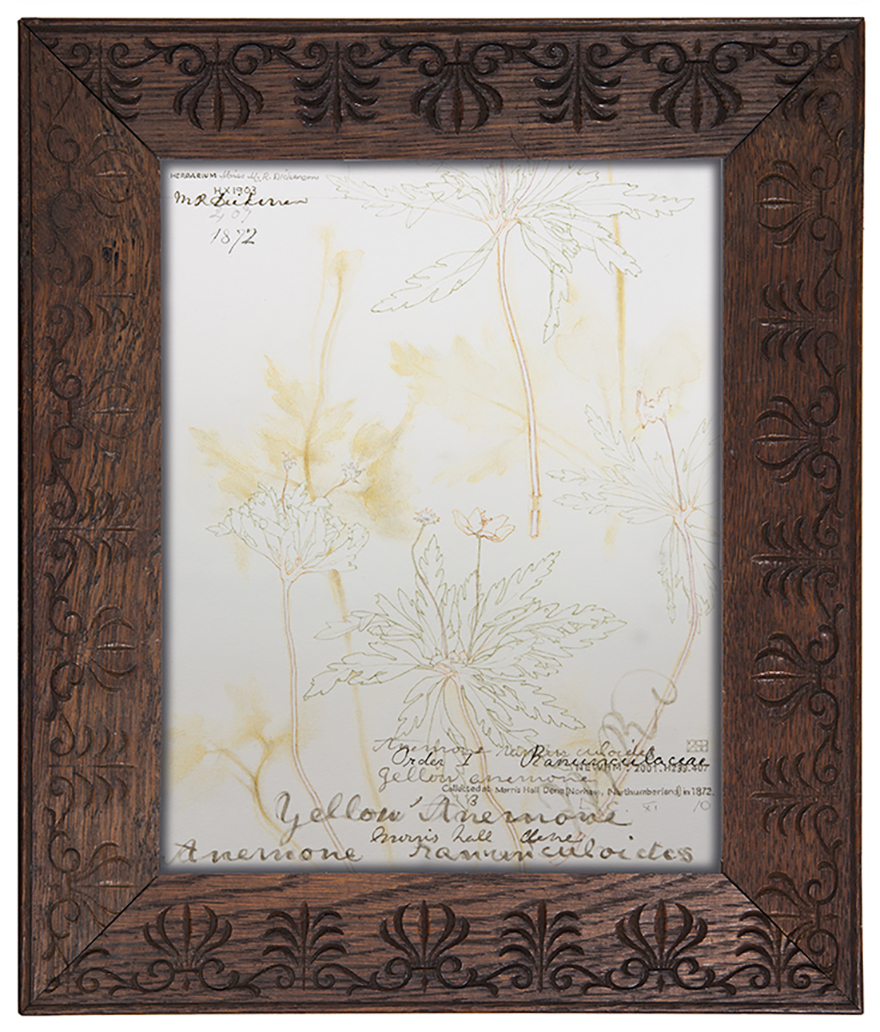 Study of Anemone RanunculoidesI was inspired by the pressed specimen of anemone ranunculoides in the Margaret Rebecca Dickinson (a Victorian botanist) archive in the Natural History Society of Northumbria. This pressed specimen sheet has, in addition to the delicate pressed plants, 'ghost' images of other pressed specimens which have transferred over time, on to the mounting paper. There is a suggestion of 'Momento Mori' (a reflection on mortality) where the physical presence of the dead plants exists alongside the physical trace of the long absent anemones. I tried to give equal expression to the 'body' and 'essence' of the natural world in this drawing.
Study of Anemone RanunculoidesI was inspired by the pressed specimen of anemone ranunculoides in the Margaret Rebecca Dickinson (a Victorian botanist) archive in the Natural History Society of Northumbria. This pressed specimen sheet has, in addition to the delicate pressed plants, 'ghost' images of other pressed specimens which have transferred over time, on to the mounting paper. There is a suggestion of 'Momento Mori' (a reflection on mortality) where the physical presence of the dead plants exists alongside the physical trace of the long absent anemones. I tried to give equal expression to the 'body' and 'essence' of the natural world in this drawing.
h:34cms x w:29cms (framed).
Coloured pencil
2018 -
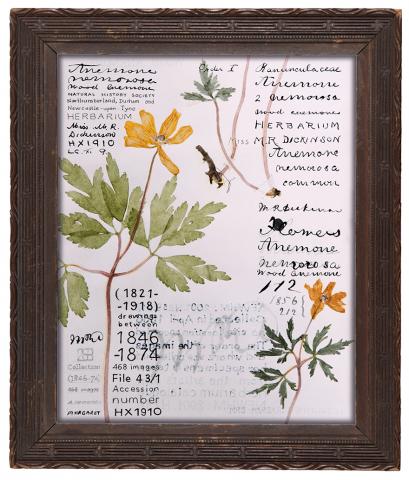 Study of Anemone Nemorosa
Study of Anemone Nemorosa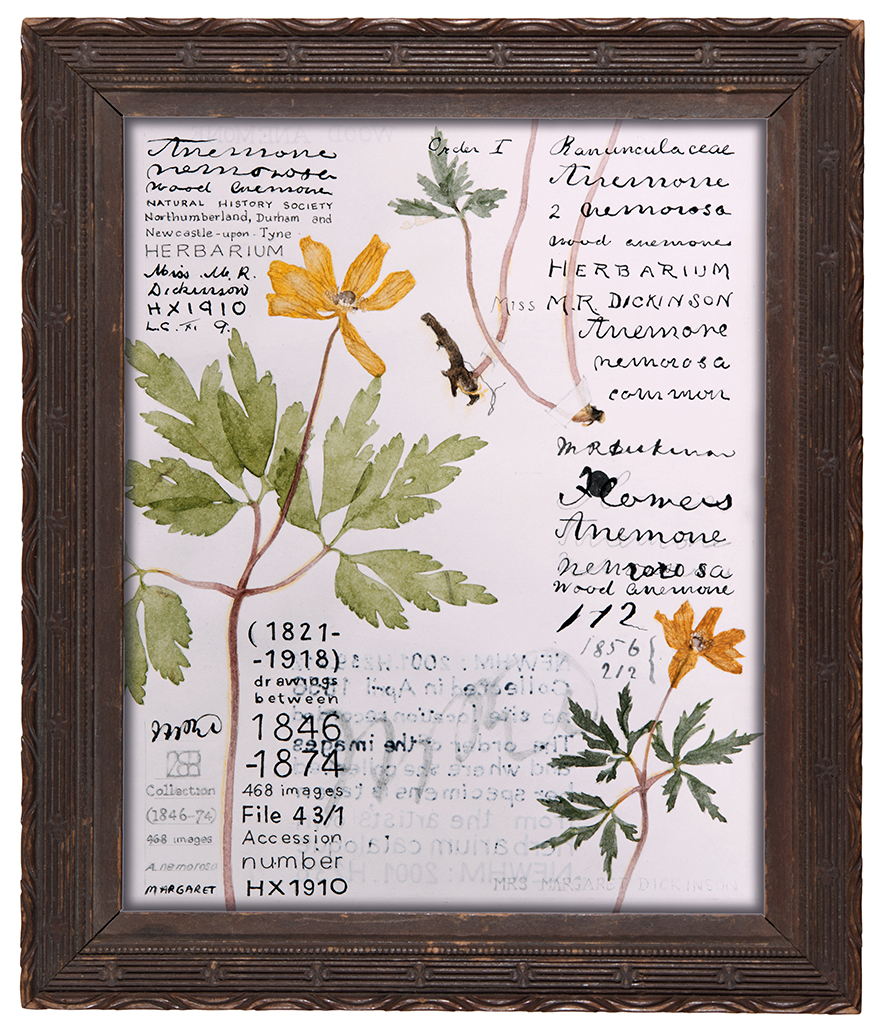 Study of Anemone NemorosaInspired by the pressed specimen of Anemone nemorosa in the Margaret Rebecca Dickinson (a Victorian botanist) archive in the Natural History society of Northumbria, the simple arrangement of the two flowers placed side by side suggested the composition of this drawing. The anemones are shown 1:1 scale and, by adapting botanical drawing conventions, I intertwined the two stems to pull the two halves of the drawing together. I used translucent sketchbook paper to allow the text on the reverse to show through referencing the quality of antique books and layered understanding. The paper also allows the watercolour to lie very flat and matt which captures something of the delicacy and texture of the plants.
Study of Anemone NemorosaInspired by the pressed specimen of Anemone nemorosa in the Margaret Rebecca Dickinson (a Victorian botanist) archive in the Natural History society of Northumbria, the simple arrangement of the two flowers placed side by side suggested the composition of this drawing. The anemones are shown 1:1 scale and, by adapting botanical drawing conventions, I intertwined the two stems to pull the two halves of the drawing together. I used translucent sketchbook paper to allow the text on the reverse to show through referencing the quality of antique books and layered understanding. The paper also allows the watercolour to lie very flat and matt which captures something of the delicacy and texture of the plants.
h:25.5cms x w:21.5cms (framed).
watercolour and pencil on paper
2018 -
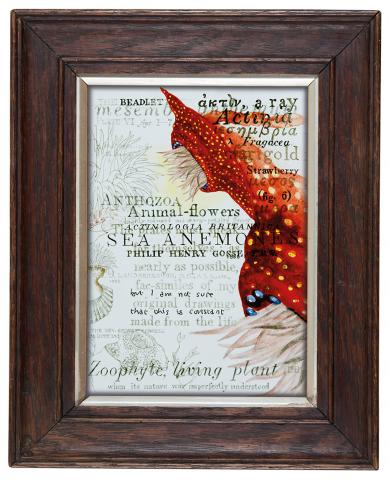 Study from P. H. Gosse's Actinia Mesembryanthemum
Study from P. H. Gosse's Actinia Mesembryanthemum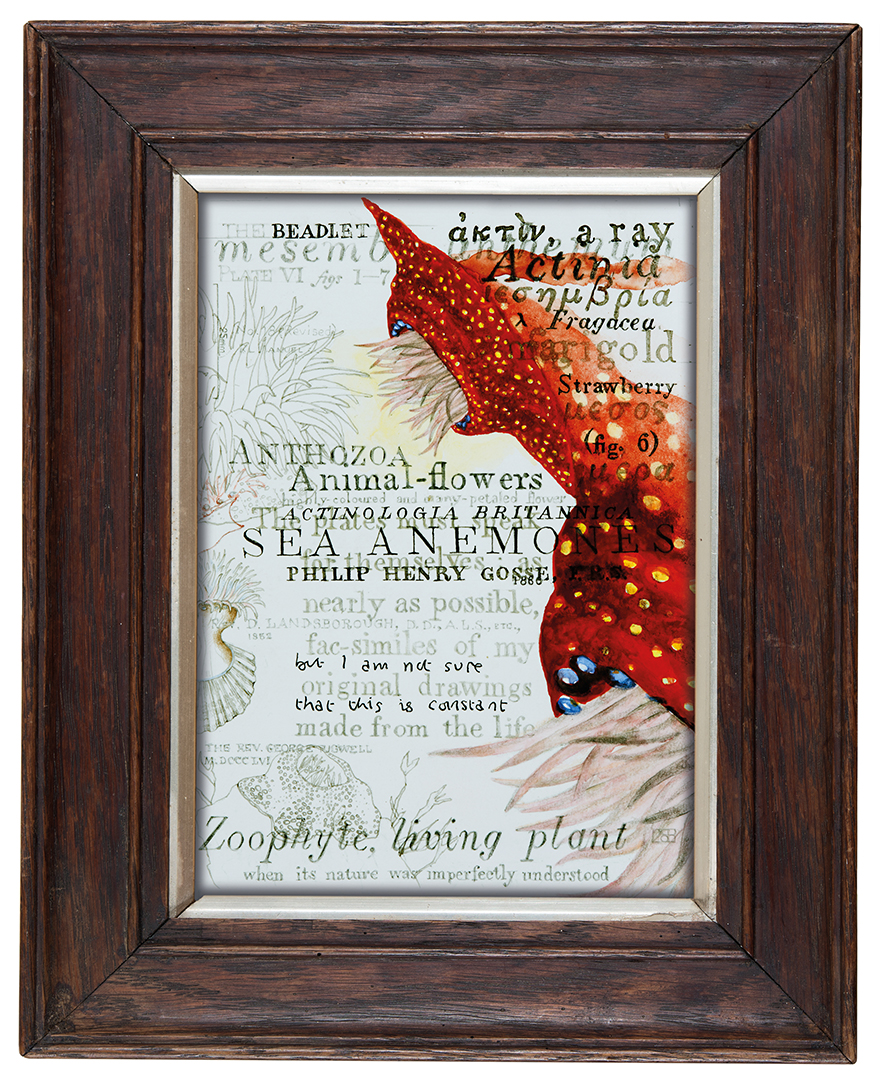 Study from P. H. Gosse's Actinia MesembryanthemumIt was a joy to handle an original copy of Philip Henry Gosse's book 'A History of the British Sea Anemones and Corals' (published 1860) during my research. The illustrated plates were exquisite and the typography and content were so atmospheric and of their time, that I decided to closely study his plate VI of Actinia mesembryanthemum (Beadlet anemone) and Actinia fragacea (Strawberry anemone). (This would inform a later drawing made from a Leopold Blaschka glass model of a beadlet anemone held in the Discovery museum archive.) I was intrigued and charmed by Gosse's earnest assertion that these images were '...made from the life...' as this makes an intriguing counterpoint to how Blaschka initially sourced his imagery. The scientific exchange of information and occasional unintentional misinterpretation of natural history discoveries (for example, the confusion over anemones being animals or plants) is a wonderful expression of the necessarily imperfect human search for understanding. This 'slippage' in naming and labeling provides a fascinating artistic space to explore the human need for, and struggle to reach, a satisfactory explanation or truth not only for our understanding of the world around us but of ourselves.
Study from P. H. Gosse's Actinia MesembryanthemumIt was a joy to handle an original copy of Philip Henry Gosse's book 'A History of the British Sea Anemones and Corals' (published 1860) during my research. The illustrated plates were exquisite and the typography and content were so atmospheric and of their time, that I decided to closely study his plate VI of Actinia mesembryanthemum (Beadlet anemone) and Actinia fragacea (Strawberry anemone). (This would inform a later drawing made from a Leopold Blaschka glass model of a beadlet anemone held in the Discovery museum archive.) I was intrigued and charmed by Gosse's earnest assertion that these images were '...made from the life...' as this makes an intriguing counterpoint to how Blaschka initially sourced his imagery. The scientific exchange of information and occasional unintentional misinterpretation of natural history discoveries (for example, the confusion over anemones being animals or plants) is a wonderful expression of the necessarily imperfect human search for understanding. This 'slippage' in naming and labeling provides a fascinating artistic space to explore the human need for, and struggle to reach, a satisfactory explanation or truth not only for our understanding of the world around us but of ourselves.
h:27cms x w:21.7cms (framed).
watercolour and pencil on paper
2018 -
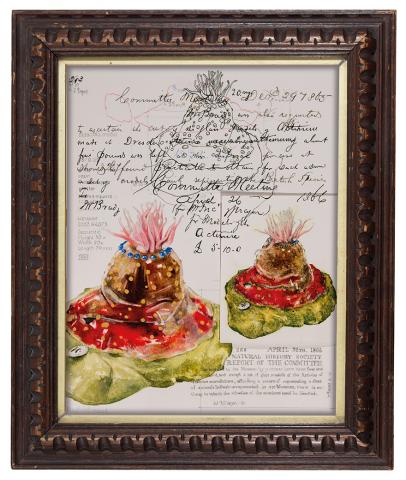 Study of Blaschka Beadlet Anemone
Study of Blaschka Beadlet Anemone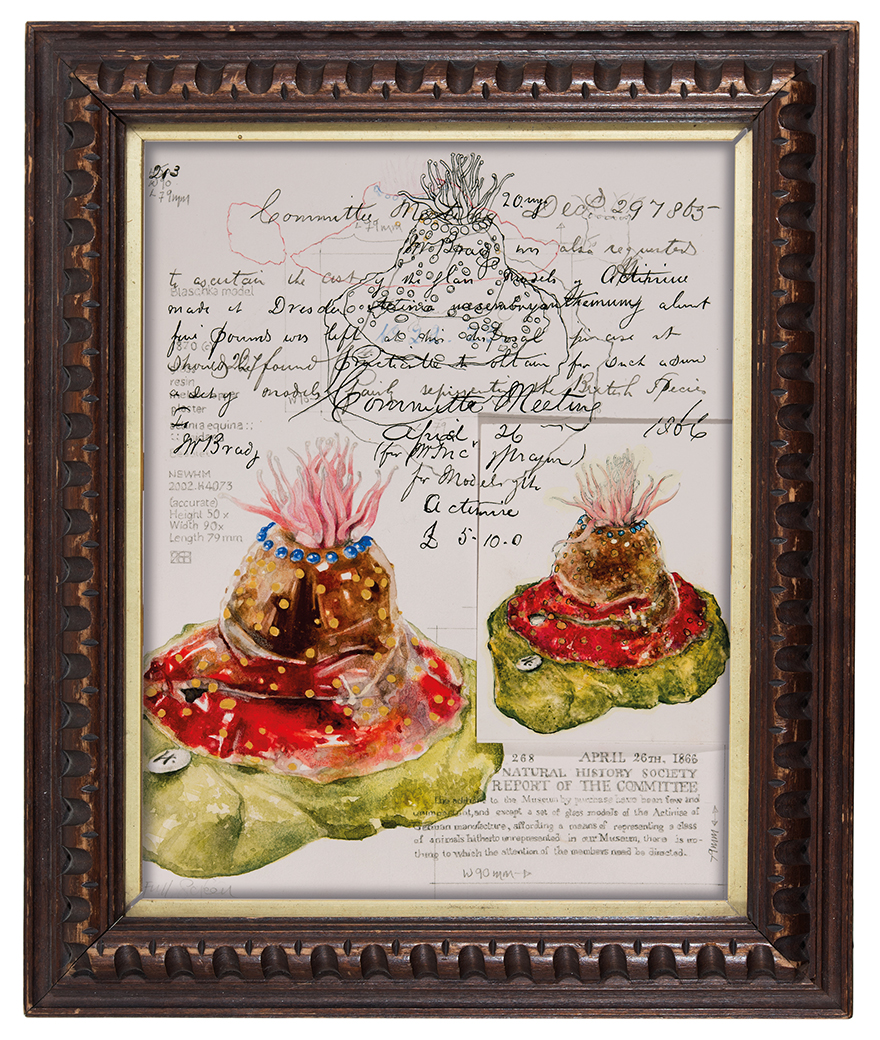 Study of Blaschka Beadlet AnemoneI was enchanted by the Natural History Society of Northumbria's collection of exquisite scientific glass models of sea anemones made by Leopold Blaschka (1822-1895) and his son Rudolph. I concentrated on the Beadlet anemone model as it related well to the P. H. Gosse book I studied previously. There is a poetic quality to Blaschka's exquisitely delicate use of glass as the only way to preserve the ephemeral forms and colours of these sea creatures at the time: impossible to preserve animals have been imortalised in almost impossibly fragile models. Blaschka only observed living anemones later in his career, so he initially used illustrations and the verbal and written specimen observations from others to inform his models. In the hundred-plus years since their making, whatever 'mistakes' there are in the models' accuracy or identifications only give added poignancy to our search for understanding. My drawing reflects one moment in the continuing narrative of Blashcka's models. I have placed my 'unfinished' sketchbook studies from the model among texts from the Society's records and Blaschka's drawings. There is a layering of differing representations of this Beadlet anemone from early verbal and pictorial records, to the three-dimensional model and back to my two-dimensional artwork.
Study of Blaschka Beadlet AnemoneI was enchanted by the Natural History Society of Northumbria's collection of exquisite scientific glass models of sea anemones made by Leopold Blaschka (1822-1895) and his son Rudolph. I concentrated on the Beadlet anemone model as it related well to the P. H. Gosse book I studied previously. There is a poetic quality to Blaschka's exquisitely delicate use of glass as the only way to preserve the ephemeral forms and colours of these sea creatures at the time: impossible to preserve animals have been imortalised in almost impossibly fragile models. Blaschka only observed living anemones later in his career, so he initially used illustrations and the verbal and written specimen observations from others to inform his models. In the hundred-plus years since their making, whatever 'mistakes' there are in the models' accuracy or identifications only give added poignancy to our search for understanding. My drawing reflects one moment in the continuing narrative of Blashcka's models. I have placed my 'unfinished' sketchbook studies from the model among texts from the Society's records and Blaschka's drawings. There is a layering of differing representations of this Beadlet anemone from early verbal and pictorial records, to the three-dimensional model and back to my two-dimensional artwork.
h:31.5cms x w:26.5cms (framed).
watercolour and pencil on paper
2018 -
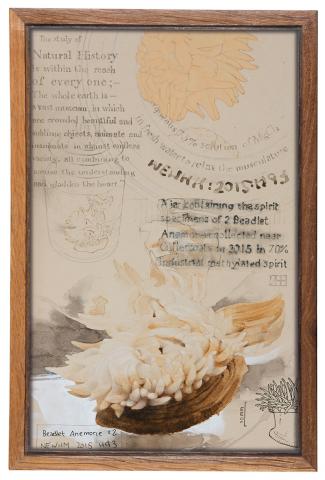 Study of Spirit Beadlet Anemone
Study of Spirit Beadlet Anemone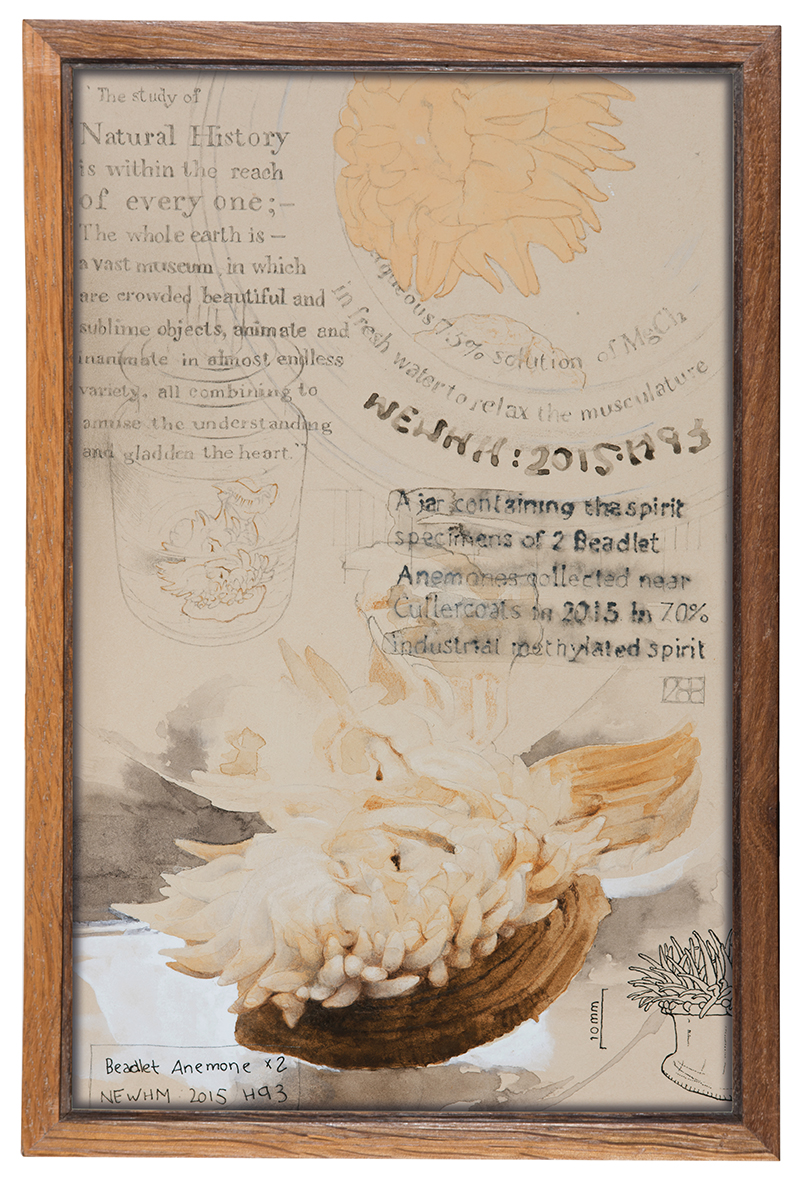 Study of Spirit Beadlet AnemoneThe distortion of the specimen necessarily observed through the curve of the glass bottle created beautiful and mysterious extensions to the form of the tiny anemone. Looking down at the specimen from above focuses attention onto the Unique Object Number written on the glass lip. To redress the balance in favour of this charming little corpse, I combined different scales and viewpoints, noted preservation liquid ingredients, included biographical details of this specimen and quoted a text about the wonder of the natural world. After the exhibition the Keeper of Biology asked if my drawing could be referenced in the archival records of this anemone: one of my finest artistic achievements to date and of which I am most proud and moved.
Study of Spirit Beadlet AnemoneThe distortion of the specimen necessarily observed through the curve of the glass bottle created beautiful and mysterious extensions to the form of the tiny anemone. Looking down at the specimen from above focuses attention onto the Unique Object Number written on the glass lip. To redress the balance in favour of this charming little corpse, I combined different scales and viewpoints, noted preservation liquid ingredients, included biographical details of this specimen and quoted a text about the wonder of the natural world. After the exhibition the Keeper of Biology asked if my drawing could be referenced in the archival records of this anemone: one of my finest artistic achievements to date and of which I am most proud and moved.
h:25.5cms x w:16.5cms (framed).
watercolour and pencil on paper
2018 -
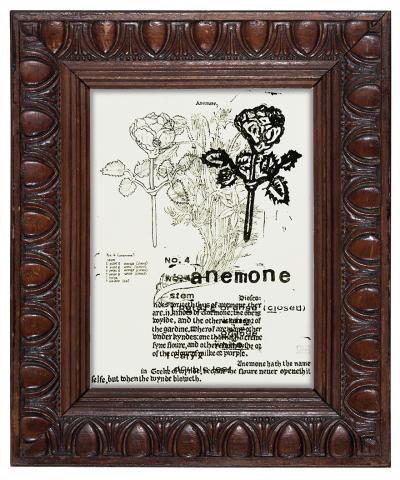 A Flowerplay and a Herball Anemone
A Flowerplay and a Herball Anemone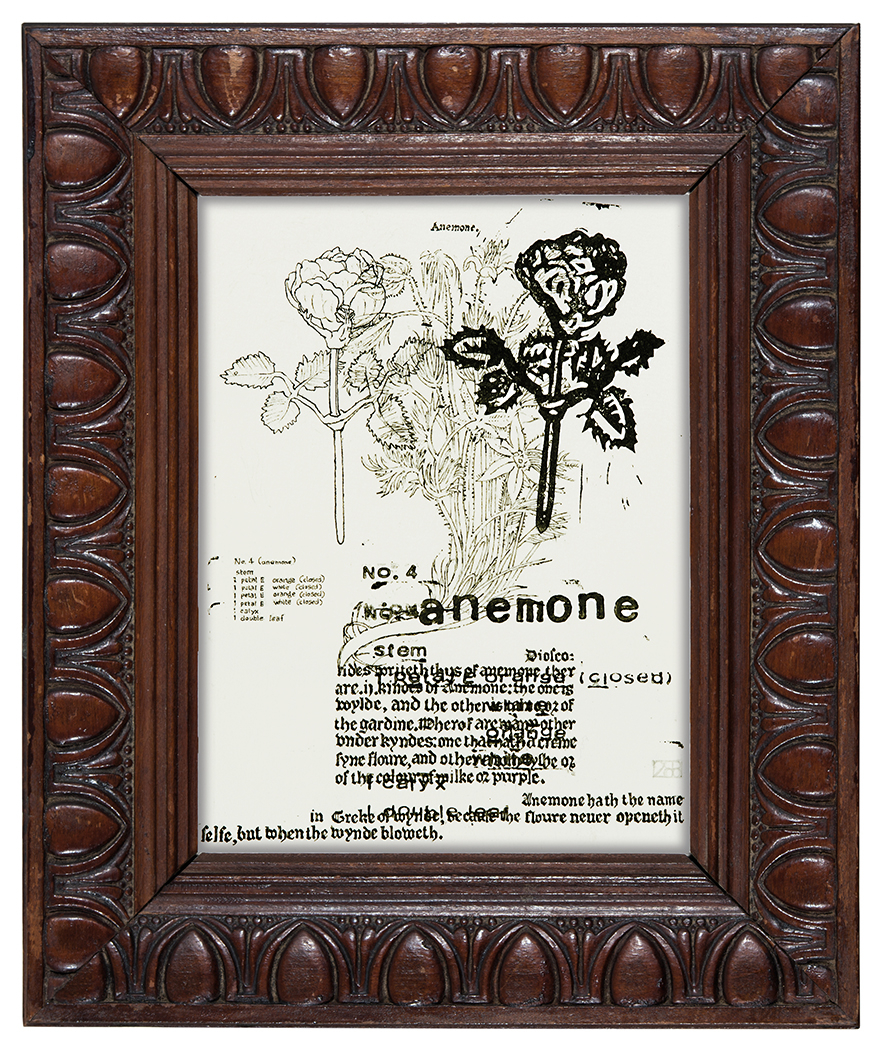 A Flowerplay and a Herball AnemoneThe starting point for the three Flowerplay drawings in this exhibition came from my childhood Spears toy set of Flower Play flowers which included assembly instructions, different plastic flower parts to make and re-make various flowers and the specific instructions on the lid for making the anemone flower. I referred to 'Juvenescance' in the exhibition title partly because the intensity with which I played with these flowers had the same degree of focus I use in my work as an artist. Also, I am mindful of the sea anemones' extraordinary ability to regenerate and defy the physical ageing process. In the Natural History Society of Northumbria Library I came across the most beautiful original book: William Turner's "A New Herball" published in 1551. The printed woodcut illustrations and text are strikingly lovely; but I was also captivated by Turner's explanation that the 'Anemone hath the name in Greke of wind... ' because the flowers only open when the wind blows. This gave me the notion of anemones of the air so I made a drawing from Turner's written and pictorial descriptions of the Anemone. I wanted to combine a unique hand drawing with a hand printed element, so I drew the Flower Play anemone, made a linocut, hand drew the printed text (all at 1:1 scale) and used my childhood John Bull printing set for the title.
A Flowerplay and a Herball AnemoneThe starting point for the three Flowerplay drawings in this exhibition came from my childhood Spears toy set of Flower Play flowers which included assembly instructions, different plastic flower parts to make and re-make various flowers and the specific instructions on the lid for making the anemone flower. I referred to 'Juvenescance' in the exhibition title partly because the intensity with which I played with these flowers had the same degree of focus I use in my work as an artist. Also, I am mindful of the sea anemones' extraordinary ability to regenerate and defy the physical ageing process. In the Natural History Society of Northumbria Library I came across the most beautiful original book: William Turner's "A New Herball" published in 1551. The printed woodcut illustrations and text are strikingly lovely; but I was also captivated by Turner's explanation that the 'Anemone hath the name in Greke of wind... ' because the flowers only open when the wind blows. This gave me the notion of anemones of the air so I made a drawing from Turner's written and pictorial descriptions of the Anemone. I wanted to combine a unique hand drawing with a hand printed element, so I drew the Flower Play anemone, made a linocut, hand drew the printed text (all at 1:1 scale) and used my childhood John Bull printing set for the title.
2018. h:28cms x w:23cms (framed).
ink on paper
2018 -
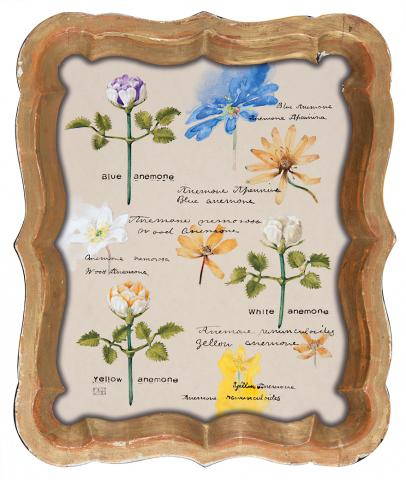 Flowerplay and Dickinson Anemones
Flowerplay and Dickinson Anemones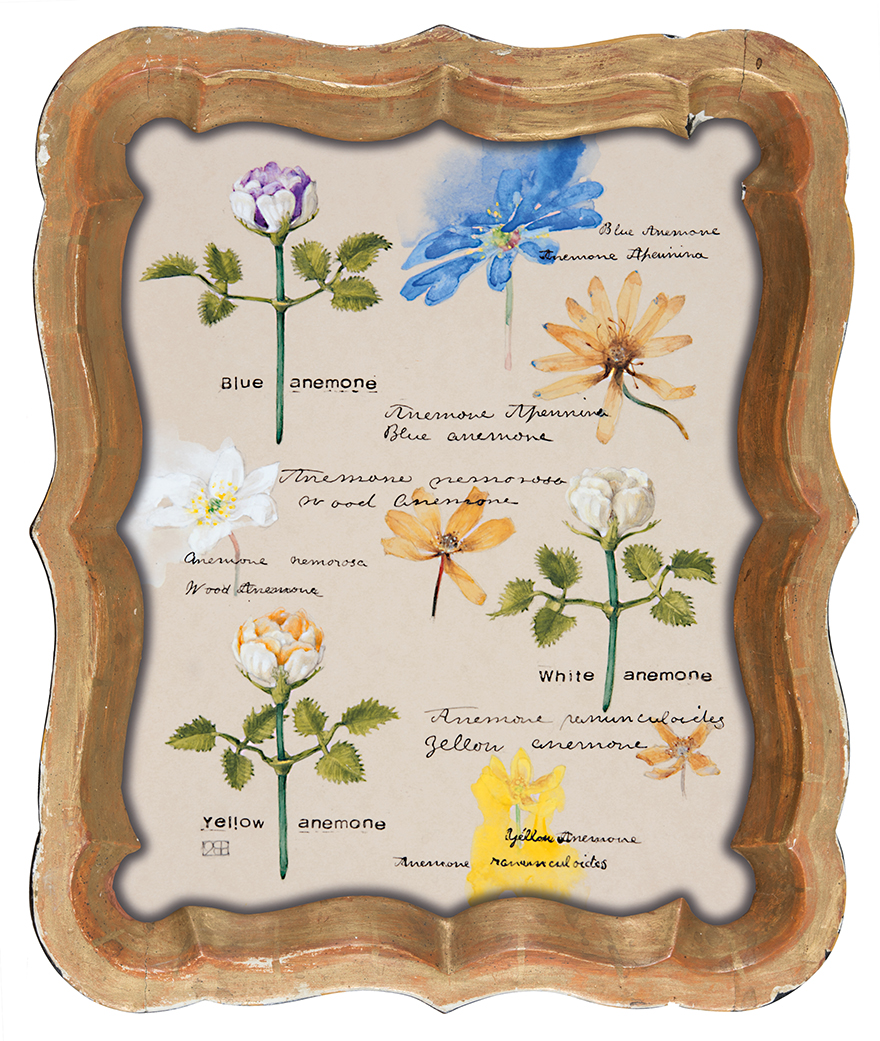 Flowerplay and Dickinson AnemonesMy starting point for this drawing was my previously mentioned Flower Play toy set. I wanted to place my much-loved toy plastic anemone alongside M. R. Dickinson's three original botanical pressed anemone specimens and her original anemone watercolor paintings. Ideas such as 'living, dead, natural, artificial, bright and faded colour, legacy, education, classification and sustainability underline this drawing. Not having the 'correct' plastic colours in my flowerplay set, I decided to make my three anemone flowers using the closest colours, albeit they are faded and brittle now and I tried to represent them as 'botanically' accurate as possible. I referenced Dickinson's painted specimens by copying them as close to their original size and colour as possible, then washing them out and loosely re-painting over the top. I represented her pressed specimens at actual size but only lightly suggesting the detail. I referenced her handwritten names from both her pressed and painted specimens and used my John Bull set to title my own flowers.
Flowerplay and Dickinson AnemonesMy starting point for this drawing was my previously mentioned Flower Play toy set. I wanted to place my much-loved toy plastic anemone alongside M. R. Dickinson's three original botanical pressed anemone specimens and her original anemone watercolor paintings. Ideas such as 'living, dead, natural, artificial, bright and faded colour, legacy, education, classification and sustainability underline this drawing. Not having the 'correct' plastic colours in my flowerplay set, I decided to make my three anemone flowers using the closest colours, albeit they are faded and brittle now and I tried to represent them as 'botanically' accurate as possible. I referenced Dickinson's painted specimens by copying them as close to their original size and colour as possible, then washing them out and loosely re-painting over the top. I represented her pressed specimens at actual size but only lightly suggesting the detail. I referenced her handwritten names from both her pressed and painted specimens and used my John Bull set to title my own flowers.
h:30cms x w:25.5cms (framed).
watercolour and pencil on paper
2018 -
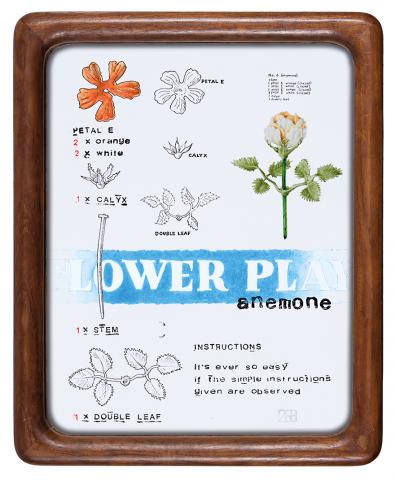 How to Flowerplay an Anemone
How to Flowerplay an Anemone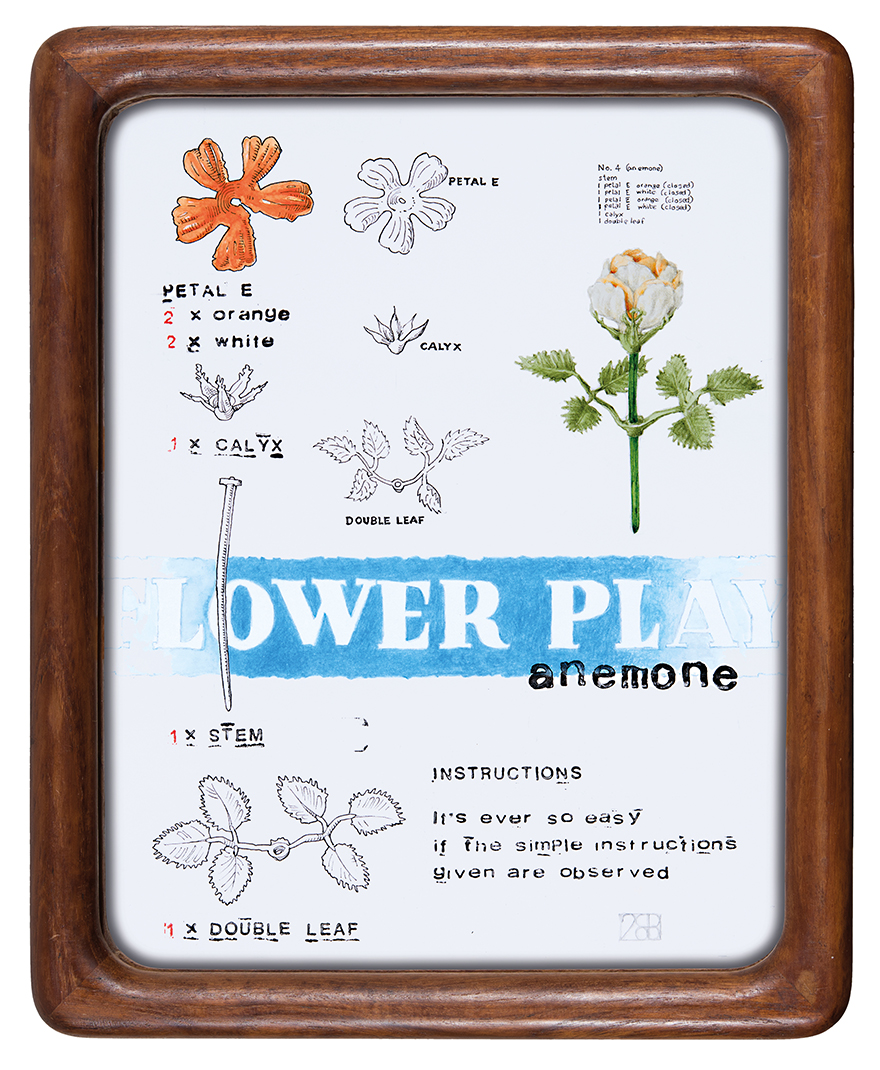 How to Flowerplay an AnemoneMy starting point for this drawing was my previously mentioned Flower Play toy set. As a child I played with this set often and remember how at first I carefully concentrated on the 'correct' order following the given instructions on the lid, but later I let my imagination create any flower I desired from the pieces supplied. The acute attention and knowledge a child has for a favoured toy shows that through play there is not only a rigour of understanding of the toy itself and the rules which are applied to it, but also focuses the love which is bestowed on the toy. I wanted to show this knowledge I had of my toy and equate it with that which a botanical artist (and perhaps natural history scientist) engages with his or her subject. I drew from the printed instructions, repeated the same style when drawing the actual pieces of the flower and the drew a 'botanical' representation of the plastic flower, all at 1:1 scale. I printed the accompanying texts using my toy printing sets.
How to Flowerplay an AnemoneMy starting point for this drawing was my previously mentioned Flower Play toy set. As a child I played with this set often and remember how at first I carefully concentrated on the 'correct' order following the given instructions on the lid, but later I let my imagination create any flower I desired from the pieces supplied. The acute attention and knowledge a child has for a favoured toy shows that through play there is not only a rigour of understanding of the toy itself and the rules which are applied to it, but also focuses the love which is bestowed on the toy. I wanted to show this knowledge I had of my toy and equate it with that which a botanical artist (and perhaps natural history scientist) engages with his or her subject. I drew from the printed instructions, repeated the same style when drawing the actual pieces of the flower and the drew a 'botanical' representation of the plastic flower, all at 1:1 scale. I printed the accompanying texts using my toy printing sets.
h:28cms x 23.5cms (framed).
watercolour and ink and pencil on paper
2018 -
 Anomones Exhibition View 2. Natural History Society of Northumbria Library
Anomones Exhibition View 2. Natural History Society of Northumbria Library Anomones Exhibition View 2. Natural History Society of Northumbria LibraryView of Anemones Exhibition in the Natural History Society of Northumbria library, 2018.
Anomones Exhibition View 2. Natural History Society of Northumbria LibraryView of Anemones Exhibition in the Natural History Society of Northumbria library, 2018.
2017 -
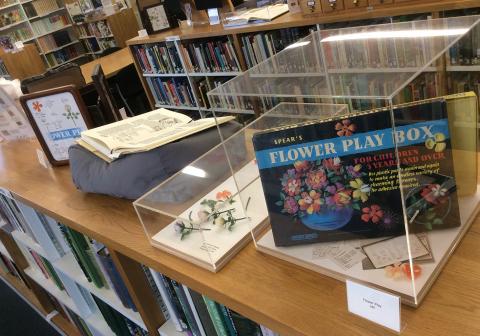 Anemones Exhibition Flower Play Box
Anemones Exhibition Flower Play Box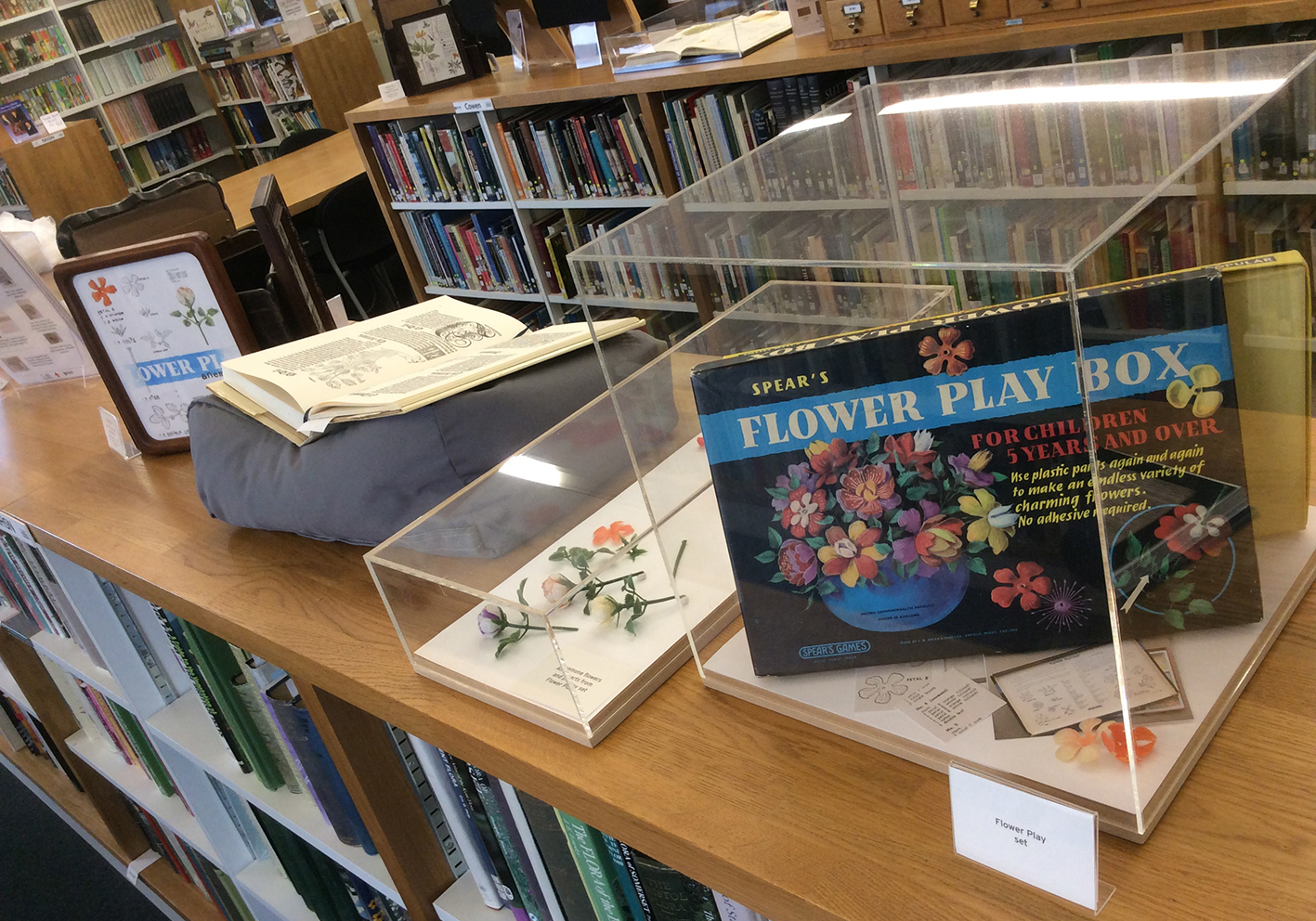 Anemones Exhibition Flower Play BoxThis image shows the 1970s Flower Play box, the plastic anemone flowers made from the set and the drawing 'How to Flowerplay an Anemone' in situ in the Natural History Society of Northumbria library in 2018.
Anemones Exhibition Flower Play BoxThis image shows the 1970s Flower Play box, the plastic anemone flowers made from the set and the drawing 'How to Flowerplay an Anemone' in situ in the Natural History Society of Northumbria library in 2018.
2018 -
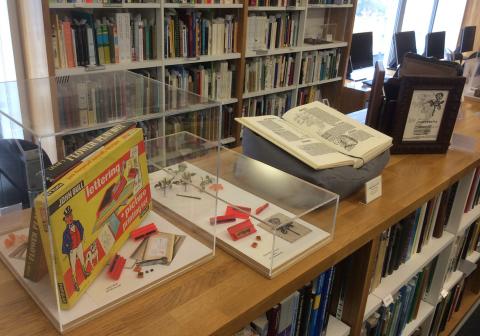 Anemones Exhibition John Bull Box
Anemones Exhibition John Bull Box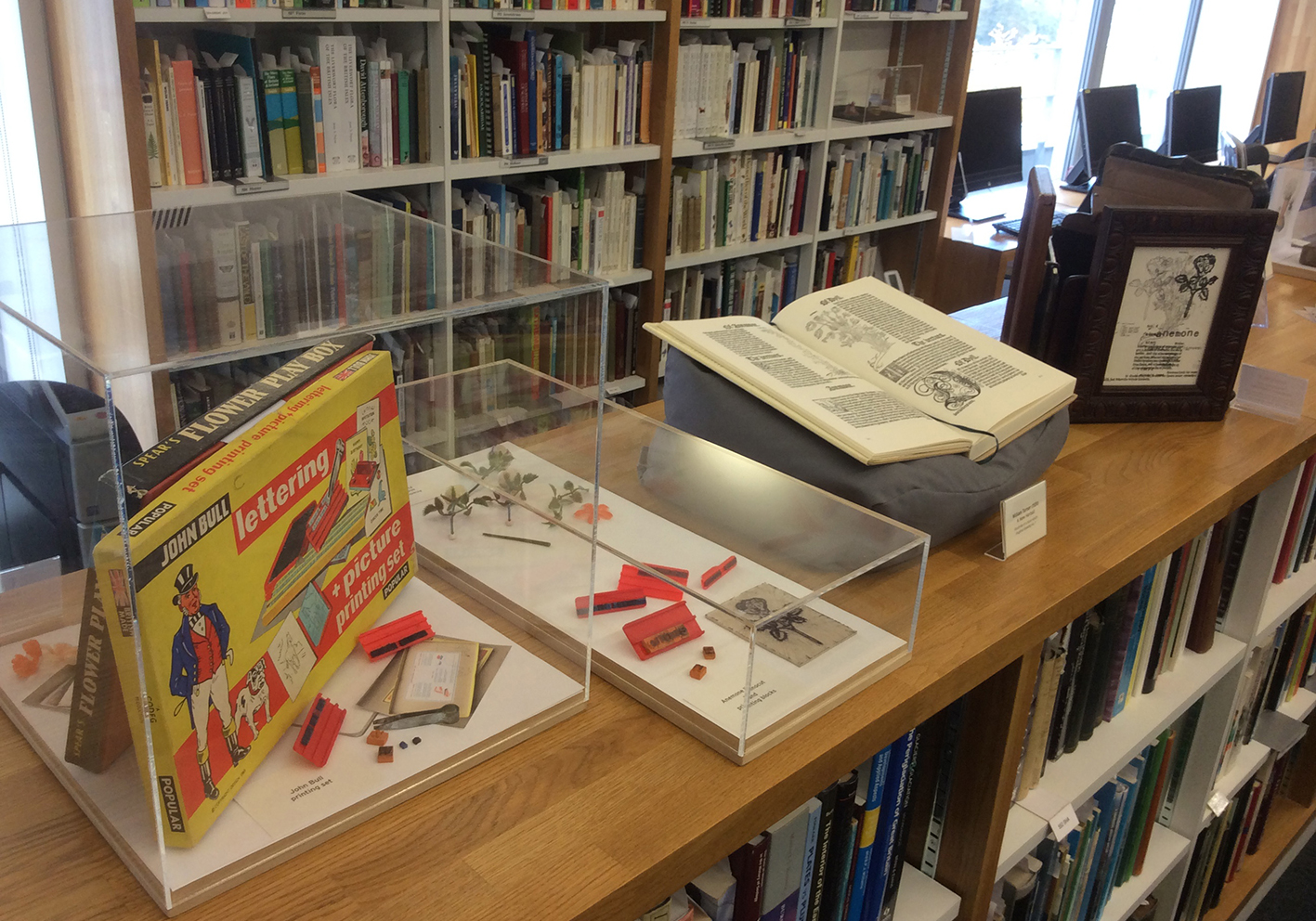 Anemones Exhibition John Bull BoxThis image shows the John Bull printing set and labels, the anemone linocut, and a reproduction of William Turner's book 'A New Herball': all of which are part of the drawing 'A Flowerplay and a Herball Anemone': shown in situ in the Natural History Society of Northumbria library in 2018.
Anemones Exhibition John Bull BoxThis image shows the John Bull printing set and labels, the anemone linocut, and a reproduction of William Turner's book 'A New Herball': all of which are part of the drawing 'A Flowerplay and a Herball Anemone': shown in situ in the Natural History Society of Northumbria library in 2018.
2018 -
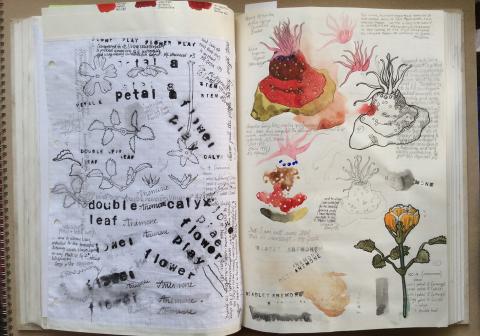 Anemones Exhibition Sketchbook Pages
Anemones Exhibition Sketchbook Pages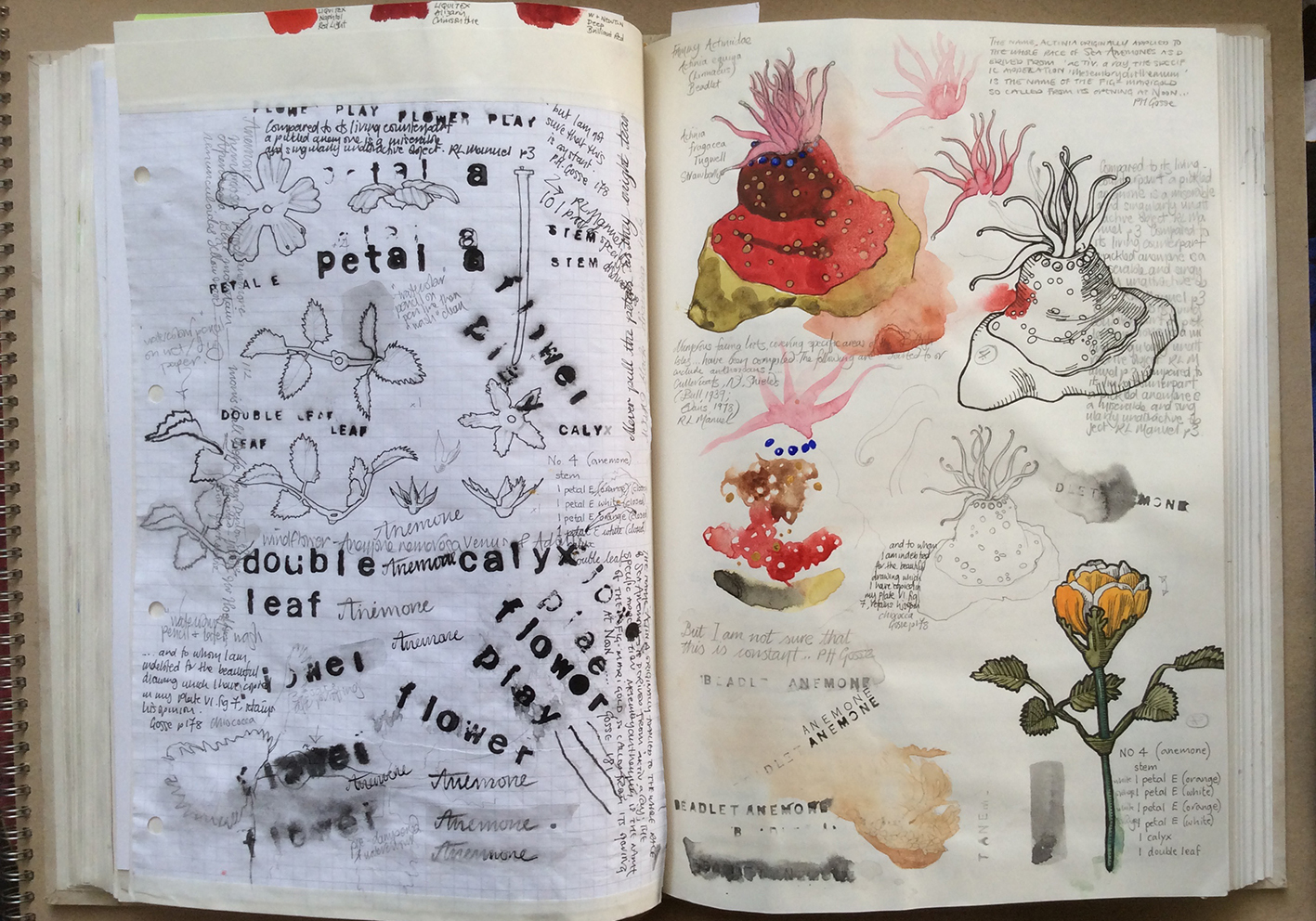 Anemones Exhibition Sketchbook PagesTwo pages from my sketchbook showing ideas progression for the 'Anemones' exhibition. I was experimenting with typography and materials, recording quotations from archive sources, colour studies of Blaschka's model of the Beadlet anemone and trying out a sketch towards the anemone linocut.
Anemones Exhibition Sketchbook PagesTwo pages from my sketchbook showing ideas progression for the 'Anemones' exhibition. I was experimenting with typography and materials, recording quotations from archive sources, colour studies of Blaschka's model of the Beadlet anemone and trying out a sketch towards the anemone linocut.
h:33cms x w:48cms.
2018 -
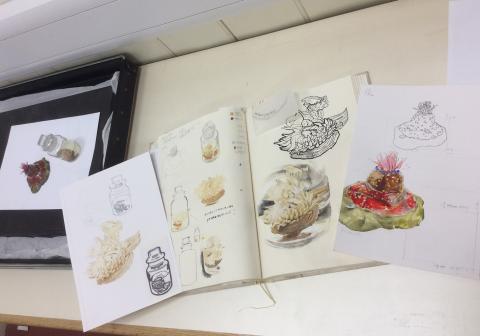 Anemones Exhibition Blaschka and Spirit beadlet and Sketchbook
Anemones Exhibition Blaschka and Spirit beadlet and Sketchbook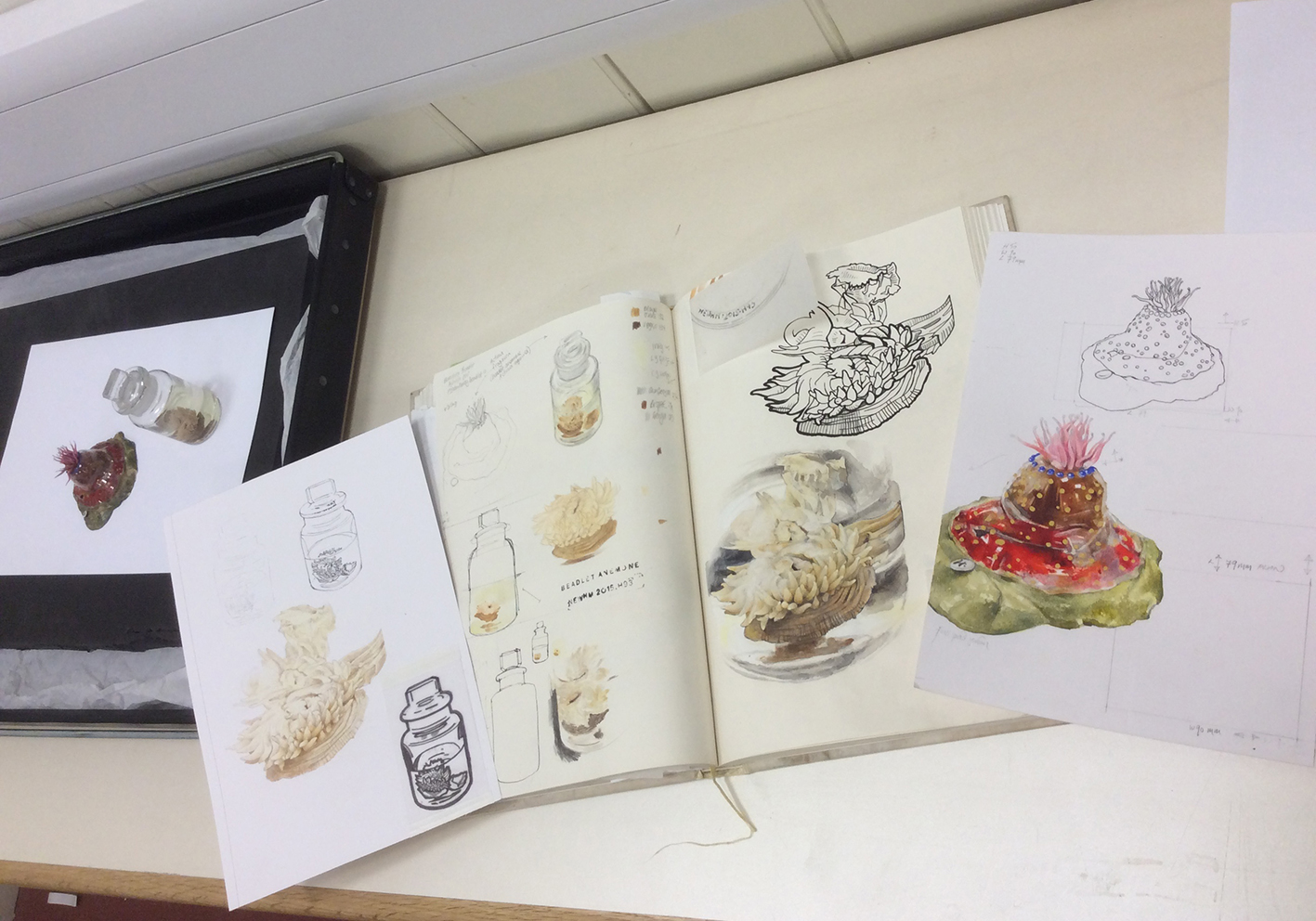 Anemones Exhibition Blaschka and Spirit beadlet and SketchbookThis image was taken in situ showing the Natural History Society of Northumbria's Blaschka glass model of a Beadlet anemone and the Beadlet anemone in the Spirit collection- both are stored in the archives of the Great North Museum: Discovery. Alongside them is shown my sketchbook with studies of the same.
Anemones Exhibition Blaschka and Spirit beadlet and SketchbookThis image was taken in situ showing the Natural History Society of Northumbria's Blaschka glass model of a Beadlet anemone and the Beadlet anemone in the Spirit collection- both are stored in the archives of the Great North Museum: Discovery. Alongside them is shown my sketchbook with studies of the same.
Pencil
2018 -
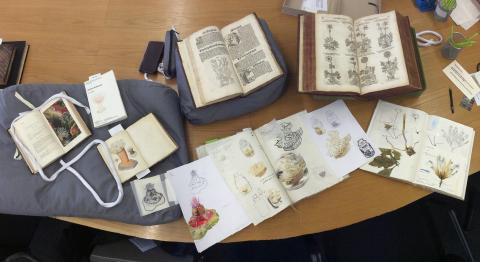 Anemones Exhibition Sketchbook and Source Books
Anemones Exhibition Sketchbook and Source Books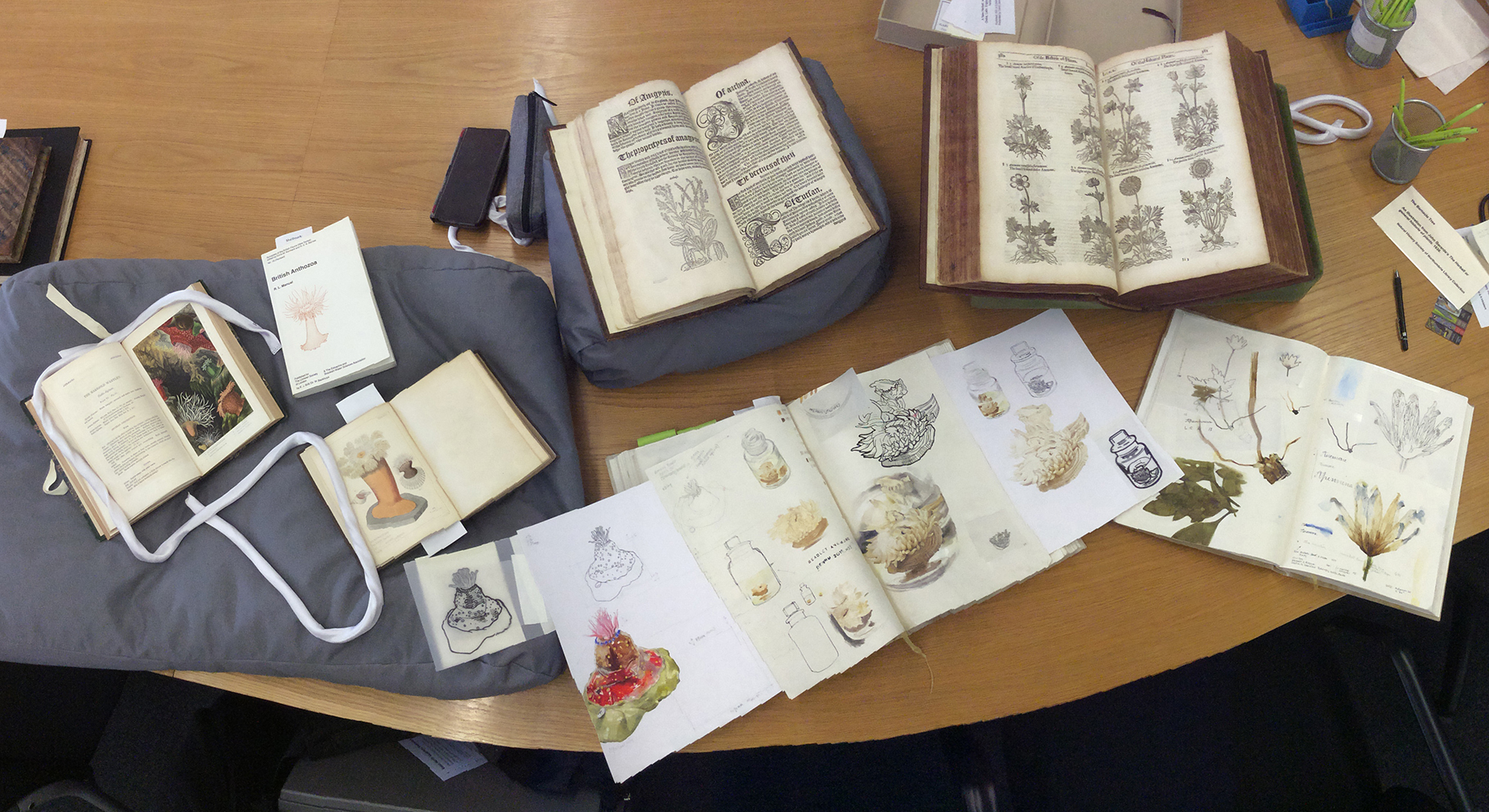 Anemones Exhibition Sketchbook and Source BooksThis image was taken in the library of the Natural History Society of Northumbria showing a selection of original books I used as inspiration for my Anemones exhibition in 2018 alongside some of my sketchbook studies.
Anemones Exhibition Sketchbook and Source BooksThis image was taken in the library of the Natural History Society of Northumbria showing a selection of original books I used as inspiration for my Anemones exhibition in 2018 alongside some of my sketchbook studies.
2018 -
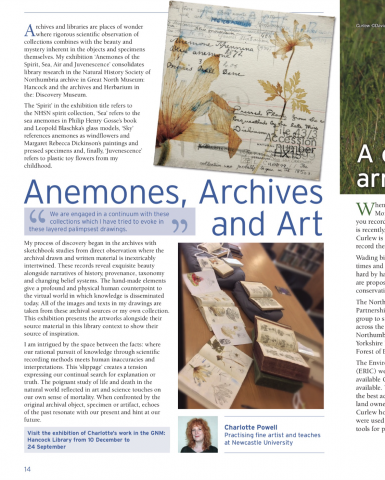 Anemones Exhibition NHSN Article
Anemones Exhibition NHSN Article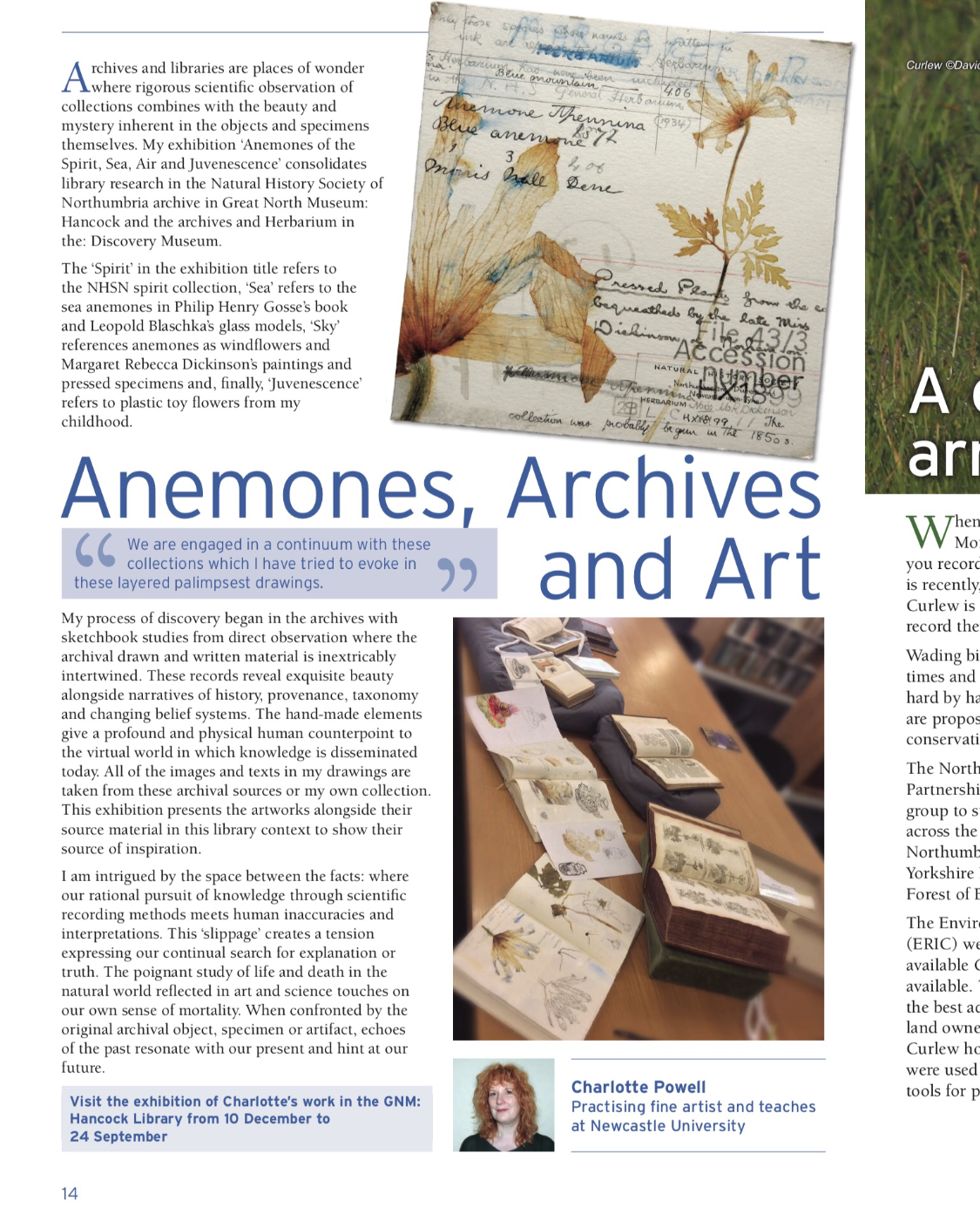 Anemones Exhibition NHSN ArticleArticle on my Anemones exhibition from 'North East Nature' (the bulletin of the Natural History Society of Northumbria), Number 298, page 14, Summer 2018.
Anemones Exhibition NHSN ArticleArticle on my Anemones exhibition from 'North East Nature' (the bulletin of the Natural History Society of Northumbria), Number 298, page 14, Summer 2018.
2018
